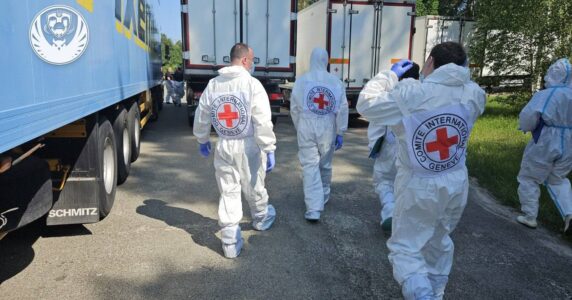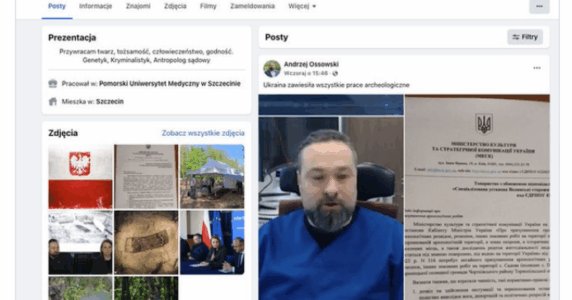Navigation and useful materials
Moscow decided not to escalate the situation around the Saki airfield and to put 5% of Mykolaiv oblast together with the occupied territory of Kherson oblast. The Centre for Strategic Communication and Information Security has collected the main fakes and narratives of the Russian propaganda of August 9.
- The explosions in Saki to be called “negligence”
- Special operation to reconnect ZNPP
- The occupiers are redrawing the map of Ukraine
- 23 years of Putin on the political landscape
The explosions in Saki to be called “negligence”
The explosions at the airfield in Saki in the occupied Crimea were probably still detonating when Russia generated countless versions of what actually happened. These versions had a range as big as the debris field following the explosion: from a direct hit by the American long-range ATACMS missile to a cigarette butt that somebody forgot to put in the bin.
The picture was as impressive as any Hollywood disaster film: distant “mushrooms” of explosions filmed by beach-goers, panic and mayhem, a huge traffic congestion next to the Crimean bridge, ambulances, fire trucks and sanitary aviation planes. Emergency statements live on air from various officials only made the situation seem more solemn.
Russia’s MoD commented on the explosions the following way: “About 15:20, on the territory of Saki airfield, several aviation munitions detonated at the storage area. No one was injured as a result of the explosion. Aviation equipment at the airfield is not damaged.”
Eventually, the Russian MoD decided: “The main reason of the emergency at the Saki airfield currently considered is only a violation of fire safety rules. There are no signs, evidence, and even more so facts of intentional impact on ammunition for the purpose of detonation.”
As of 8:00 p.m., one dead and several wounded were officially announced. There were two children among them. Of course, it’s unclear what they were doing at a “storage area” with “several aviation munitions.”
READ ALSO: Shoigu Will Point a Finger at FSB for the UAV in Sevastopol
This time, Moscow did not think long and issued an order to consider the “emergency event in Saki” as resulting not from a Ukrainian attack, but from the negligence of a certain “Private Tursunkulov,” who violated fire safety rules.
Ukraine’s MoD, on the other hand, did not insist on its involvement and mostly treated the situation with some humour.
Of course, the temptation to find Biden’s business cards, Zaluzhnyi’s DNA or at least feathers of kamikaze birds raised in American biolabs was high for Russian “military correspondents.”
But Moscow said no.
Recognizing a sabotage would once again show that the FSB was unable to prevent it. Recognizing a missile strike would mean admitting to a complete failure of the air defence in Crimea.
In any case, the discussion of “sabotage vs. missile” in Russian media stopped at once. Nobody made any demands any more. A disaster film from Saki was replaced with a drama with a former Hollywood celebrity and current “useless idiot” Steven Seagal, who arrived in Olenivka to investigate “Nazi atrocities.”
READ ALSO: How Russian propaganda supported the murder of Azov prisoners of war in Olenivka
So, for the moment, the Kremlin has decided to pretend that everything is in perfect order, with the exception of minor technical problems. If they admit that the problems are neither minor nor technical, the consequences will be much more series. Everyone was told to keep calm about Crimea being and staying Russian, even though its so-called “leader” Aksyonov announced the “yellow” (high) level of terrorist threat in the region until August 24.
The Kremlin will probably maintain its fake stories how Russians have nothing to fear. They do, though.
Special operation to reconnect ZNPP
At the same time we are effectively witnessing how the story is constructed about “Ukrainian Nazis” allegedly putting Zaporizhia nuclear power plant in danger. Russia is having a hysterical fit about a potential attack of the Armed Forces of Ukraine on the plant.
This hysteria was “elegantly” embedded in the tragic dates in history associated with the atomic bombings of Hiroshima and Nagasaki.
IN REALITY, the entire Russian propaganda campaign around Zaporizhia NPP is about the sole purpose of capturing it. Everything else is just noise trying to show that Russia “protects Europe’s nuclear safety, and therefore, took its biggest nuclear power plant under control.” And it was probably for protection that Russia fused it with explosives.
Watch the steps.
On August 7, Russian media reports that Ukrainians allegedly shelled Enerhodar, and on the 8th — that they targeted ZNPP itself.
On August 9, president of Energoatom Petro Kotin discloses the plan to reconnect ZNPP to the occupied Crimea, and the first point of this plan is to fully disable the grid in Kherson and Zaporizhia oblasts.
In other words, “due to danger,” Russians are cutting power in two Ukrainian oblasts. Later, they may “heroically” reconnect them, but in a way that ZNPP would no longer return to Ukraine.
The IAEA commission (which is considered loyal to Moscow) will probably be admitted to the station later; it will say how deeply concerned it is, but that the plant works safely, and they do not get involved in politics. And that’s it.
Thus, the capture and reconnection of the ZNPP is just a mini-copy of the whole story about “Russia was forced to resort to a special operation in Ukraine to prevent danger from its side.”
Russia is currently “reconnecting” other captured infrastructure objects to service Russia instead of Ukraine, too: seaports, plants, etc.
The occupiers are redrawing the map of Ukraine
Meanwhile, the Kremlin is already redrawing the map of Ukraine. “The liberated territories of Mykolaiv oblast will be united with Kherson oblast.” This was reported by the so-called deputy head of the temporary administration of Kherson oblast Gubareva on August 9.
Especially given Russia’s huge experience with this. It is reported that since the beginning of the full-scale war, 3.2 million refugees from Ukraine have arrived in the Russian Federation. This is almost the same as the entire population of Bosnia and Herzegovina. This is more than the population of Moldova, Albania, Slovenia, Macedonia, Iceland or the Baltic States.
The International Day of the World’s Indigenous Peoples was celebrated on August 9. On this occasion, we should mention that Russia’s new experience in deportations is based on a rich historical background:
- 1930 — eviction of Estonians, Latvians, Lithuanians, Poles, Germans, and Finns from Leningrad.
- 1936 — deportation of 65,000 Poles and Germans from Ukraine.
- 1937 – deportation of 172,000 Koreans from the Far East.
- 1941 — deportation of Soviet Germans.
- 1943 – 1944 — deportations of Kalmyks, Ingush, Chechens, Crimean Tatars, Karachays, Balkars, Nogais, Meskhetian Turks, Pontic Greeks, Bulgarians, Crimean Gypsies, Kurds, Armenians, Azerbaijanis.
- 1945-1949 — continued deportation of Armenians.
- 1939-1940, 1947 — mass deportations of Western Ukrainians.
- 1941, 1948, 1949 — mass deportations of Estonians, Latvians, and Lithuanians.
The idea of “protecting the motherland,” as the Soviet propaganda put it, is rather telling. The one thing that remains unclear is who was attacking them while they were trying to wipe entire nations off the face of the earth.
23 years of Putin on the political landscape
And finally, a few words about Putin. The occasion is good. 23 years ago, on August 9, 1999, Russian President Yeltsin appointed him, then the director of the FSB, as the Prime Minister of Russia. The same day, in his televised address, an exhausted Yeltsin officially named him his “successor.”
“He will continue the line focused on democracy and expanding Russia’s contacts. He has the energy and brains to succeed in this,” promised Yeltsin while explaining his choice.
IN REALITY, we all know how that story went. Usurpation of power. Destruction of independent media. Terror. Complete absence of civil liberties. Opposition in exile or behind bars. The Constitution effectively destroyed. A cult of the leader that can only be comparable to Stalin’s. Aggressive propaganda. Unfounded claims to world greatness. Effective isolation. From a G8 member state, Russia has turned into a country requesting help from North Korea. Impoverished, robbed and disenfranchised residents of Russia who cannot even be legitimately called “citizens.” Constant wars: Chechnya, Georgia, Syria, Ukraine.
What will happen next to the political landscape of the world? And will the world allow him to wreak havoc any longer?
If you have found a spelling error, please, notify us by selecting that text and pressing Ctrl+Enter.


